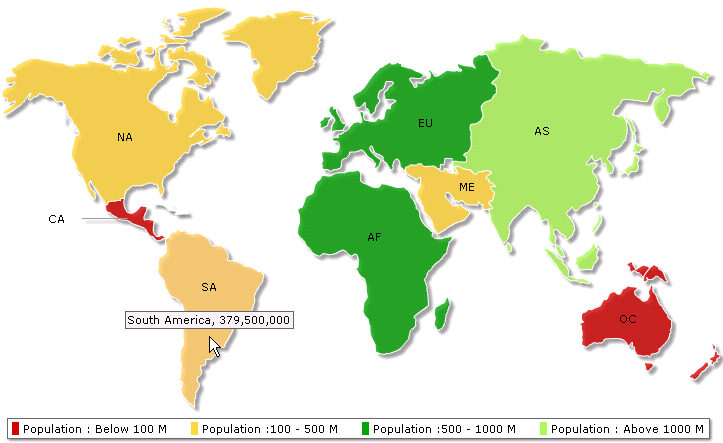FusionMaps with ASP > Using dataURL Method
Let's look at the codes used in Map Container Page and Data Provider Page one by one.
<%@ Language=VBScript %>
<%
'We've included ../Includes/FusionMaps.asp, which contains functions
'to help us easily embed the maps.
%>
<!-- #INCLUDE FILE="../Includes/FusionMaps.asp" -->
<HTML>
<HEAD>
<TITLE>FusionMaps- ASP DEMO - BASIC CHART FROM ARRAY USING dataURL method</TITLE>
<%
'We've included FusionMaps.js, which helps in
'easy map rendering.
%>
<script type="text/javascript" language="javascript" src="../JSClass/FusionMaps.js"></script>
</HEAD>
<BODY>
<%
dim dataURL
dataURL ="getURLdata.asp"
Call renderMap("../../Maps/FCMap_World8.swf", dataURL, "", "firstMapDataURL", 750, 460,0,0)
%>
</BODY>
</HTML>
- We included two files FusionMaps.asp and FusionMaps.js which help to embed the map easily.
- Then we declared a variable, dataURL that contains the name of the Data Provider Page (getURLdata.asp).
- We passed dataURL to renderMap() function which retrieves the XML and renders the map.
<%@LANGUAGE="VBSCRIPT" %>
<%
'Declare array to store world population
' we used world map with 8 entities/continents
' this 2 dimensional array will store 8 rows of data for each continent of the map
' first column of each row will store the Internal Id of each entity on the map
' second column will store population data of each entity
dim dataArray(8,2)
'Store population data
dataArray(1,1)="01" ' Internal ID of Asia
dataArray(1,2)="3779000000" ' Asia's population
dataArray(2,1)="02" ' Internal ID of Europe
dataArray(2,2)="727000000"'population
dataArray(3,1)="03"' Internal ID of Africa
dataArray(3,2)="877500000"'population
dataArray(4,1)="04"' Internal ID of North America
dataArray(4,2)="421500000"'population
dataArray(5,1)="05"' Internal ID of South America
dataArray(5,2)="379500000"'population
dataArray(6,1)="06"' Internal ID of Central America
dataArray(6,2)="80200000"'population
dataArray(7,1)="07"' Internal ID of Oceania
dataArray(7,2)="32000000"'population
dataArray(8,1)="08"' Internal ID of Middle East
dataArray(8,2)="179000000"'population
'Declare strXML to store dataXML of the map
dim strXML
'Opening MAP element
strXML = "<map showLabels='1' includeNameInLabels='1' borderColor='FFFFFF' fillAlpha='80' showBevel='0' legendPosition='Bottom' >"
'Setting Color ranges : 4 color ranges for population ranges
strXML = strXML & "<colorRange>"
strXML = strXML & "<color minValue='0' maxValue='100000000' displayValue='Population : Below 100 M' color='CC0001' />"
strXML = strXML & "<color minValue='100000000' maxValue='500000000' displayValue='Population :100 - 500 M' color='FFD33A' />"
strXML = strXML & "<color minValue='500000000' maxValue='1000000000' displayValue='Population :500 - 1000 M' color='069F06' />"
strXML = strXML & "<color minValue='1000000000' maxValue='5000000000' displayValue='Population : Above 1000 M' color='ABF456' />"
strXML = strXML & "</colorRange>"
'Opening data element that will store map data
strXML = strXML & "<data>"
'Using Data from array for each entity
FOR i=1 TO ubound(dataArray)
strXML = strXML & "<entity id='" & dataArray(i,1) & "' value='" & dataArray(i,2) & "' />"
NEXT
'closing data element
strXML = strXML & "</data>"
'closing map element
strXML = strXML & "</map>"
'Set Proper output content-type
Response.ContentType = "text/xml"
'Just write out the XML data
'NOTE THAT THIS PAGE DOESN'T CONTAIN ANY HTML TAG, WHATSOEVER
response.Write strXML
%>
- We declared a 2-dimensional array, dataArray, to store the population data and Internal IDs for 8 continents.
- Then we stored data in the array, the first column was used to store Internal IDs and the second column stored the population value of respective continents.
- Then we declared a variable strXML to store the XML of this map.
- After declaring the variable we set 4 color range to the strXML.
- Then we stored the data from the dataArray to strXML by iterating through dataArray.
- Finally, we sent this data to output stream without any HTML tags.
